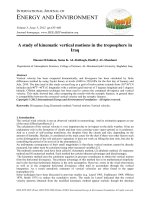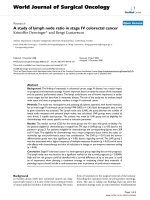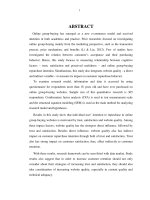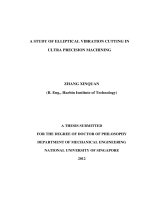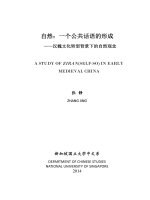A study of elliptical vibration cutting in ultra precision machining
Bạn đang xem bản rút gọn của tài liệu. Xem và tải ngay bản đầy đủ của tài liệu tại đây (2.78 MB, 175 trang )
A STUDY OF ELLIPTICAL VIBRATION CUTTING IN
ULTRA PRECISION MACHINING
ZHANG XINQUAN
(B. Eng., Harbin Institute of Technology)
A THESIS SUBMITTED
FOR THE DEGREE OF DOCTOR OF PHILOSOPHY
DEPARTMENT OF MECHANICAL ENGINEERING
NATIONAL UNIVERSITY OF SINGAPORE
2012
Acknowledgement
i
Acknowledgement
Firstly, I would like to express my deepest and earnest appreciation to my
supervisor, Associate Professor A. Senthil Kumar, for his continuous strong support,
untiring efforts, excellent supervision and patient guidance. He does not only provide
me plenty of knowledge regarding my research, but also share with me his wisdom,
insight and life attitude in the past few years. It is really my honor to achieve the
guidance from him during my PhD career.
Also, I would like to show my sincere gratitude to my co-supervisor, Professor
Mustafizur Rahman for his uninterrupted guidance, unwavering support and
encouragement throughout my study. He has constantly provided me with valuable
assistance and advice to improve both my academic research and daily life.
Special thanks to Dr. Liu Kui and Dr. Nath Chandra from Singapore Institute of
Manufacturing Technology for his continuous financial and scholastic support for my
research project. I would like to express my deep appreciation to my fiancée, my
family, and my friends for their unselfish love, encouragement, and sacrifices
throughout my life.
Last but not least, thanks to the staffs of AML: Mr. Nelson Yeo Eng Huat, Mr.
Neo Ken Soon, Mr. Tan Choon Huat, Mr. Lim Soon Cheong and Mr. Wong Chian
Loong for their time and support in operating the machines and instruments for my
experiments. Also thanks to my labmates and friends: Dr. Yu Deping, Dr. Arif, Dr.
Asma and Dr. Wang Jingjing for their academic help and inspiration.
Table of Contents
ii
Table of Contents
Acknowledgement i
Table of Contents ii
Summary vi
List of Tables viii
List of Figure s ix
Abbreviations xvi
Nomenclature xvii
Chapter 1: Introduction 1
1.1 Vibration-assisted machining (VAM) 1
1.2 Elliptical vibration cutting (EVC) 2
1.3 Main objectives of this study 3
1.4 Organization of this dissertation 4
Chapter 2: Literature review 6
2.1 Principle of VAM 6
2.1.1 Principle of CVC 6
2.1.2 Principle of EVC 8
2.2 EVC systems 13
2.2.1 Resonant EVC systems 13
2.2.2 Non-resonant EVC systems 16
2.3 Benefits of the EVC method 18
2.3.1 Smaller cutting force values 18
2.3.2 Improved surface finish 20
2.3.3 Extended tool life 23
Table of Contents
iii
2.3.4 Improved form accuracy and burr suppression 25
2.4 Analytical studies of EVC 27
2.4.1 Force models 27
2.4.2 Surface generation and critical speed ratio 29
2.4.3 FEM and MD analysis 30
2.5 Concluding remarks 32
Chapter 3: Experimental investigation of transient cutting force in EVC 34
3.1 Characteristics of the EVC process 35
3.1.1 Transient thickness of cut 35
3.1.2 Friction reversal process in the EVC process 38
3.2 Experimental details 42
3.3 Results and analysis 46
3.3.1 Effect of speed ratio 46
3.3.2 Effect of tangential amplitude 49
3.3.3 Effect of thrust amplitude 51
3.4 Concluding remarks 53
Chapter 4: Modeling of transient cutting force for the EVC method 55
4.1 Development of the force model 56
4.1.1 Transient thickness of cut 56
4.1.2 Transient shear angle and transition characteristic of friction reversal 56
4.1.3 Transient cutting force components 65
4.2 Verification for the proposed model 67
4.2.1 Calibration for the parameters 67
4.2.2 Validation for the developed model 70
4.3 Concluding Remarks 73
Chapter 5: Experimental and analytical studies of surface generation in EVC 75
Table of Contents
iv
5.1 Experimental study using the SCD tool 76
5.1.1 Experimental setup 76
5.1.2 Results and analysis 77
5.2 Development of the surface generation model considering tool edge radius 81
5.3 Experimental verification 88
5.3.1 Experimental design 88
5.3.2 Experimental results 90
5.4 Concluding remarks 93
Chapter 6: Ultrasonic EVC of hardened stainless steel using PCD tools 94
6.1 Experimental setup and procedures 95
6.2 Results and analysis 99
6.2.1 Effects of cutting parameters on force components 99
6.2.2 Effects of cutting parameters on tool wear 101
6.2.3 Effects of cutting parameters on chip formation 103
6.2.4 Effects of cutting parameters on surface roughness 105
6.2.5 Evaluation test for obtaining mirror quality surface 109
6.3 Concluding remarks 112
Chapter 7: Tool wear suppression mechanism for machining steel using diamond
with the VAM method 114
7.1 Modeling of cutting energy consumption in VAM 115
7.2 Measurement of the workpiece temperature 123
7.3 Tool wear suppression mechanism in VAM 128
7.3.1 Experimental investigation 128
7.3.2 Contamination of the tool-workpiece interface 132
7.3.3 Generation of iron oxide on the freshly machined surface 134
7.4 Concluding remarks 138
Table of Contents
v
Chapter 8: Main conclusions and recommendations 140
8.1 Main contributions 140
8.2 Recommendations for future work 143
References 146
Publication list 153
Summary
vi
Summary
In the field of precision manufacturing industry, vibration-assisted machining
(VAM) has already been demonstrated as a well-known cost-effective method for
machining various materials with superior cutting performance compared with
conventional cutting (CC) method. As a novel 2D VAM method, elliptical vibration
cutting (EVC) has received a lot of attention for its better machining performance
especially in machining brittle and hard materials. However, compared to the
conventional vibration cutting (CVC) method, very few in-depth experimental and
analytical studies have been conducted on transient cutting force, surface generation
and tool wear mechanism for the more advanced EVC method.
This study has been carried out in three phases. In the first phase, as cutting
force is considered as the most important indicator of machining state and quality, in
order to investigate the transient cutting force, a novel method is proposed to realize
the low-frequency EVC motion by G-code programming and axis motion control of
an ultraprecision machine tool. Based on this method, the transient cutting force in the
EVC process is experimentally investigated under different cutting and vibration
parameters. Then, an analytical force model is developed for in-depth understanding
of the transient cutting mechanics and for accurate prediction of the transient cutting
force. In this model, transient thickness of cut and transient shear angle are considered
and calculated, and each EVC cycle is divided into three consecutive zones (i.e. CC-
like kinetic-friction zone, static-friction zone and reverse kinetic-friction zone) based
on the variation of friction modes. Experimental verification is also carried out to
justify the validity of the developed cutting force model.
Summary
vii
In the second phase, surface generation along nominal cutting direction in EVC is
experimentally investigated by conducting a series of grooving tests using a single
crystal diamond tool. Then, in order to better understand the surface generation
process, a more comprehensive calculation method is developed for determining the
theoretical roughness considering the edge radius. The comparison between
experimental and predicted roughness shows that the proposed model could predict
much more accurate surface roughness than the prevailing model, in which the tool
edge radius is not considered.
In the third phase, commercial PCD tools are used to machine hardened stainless
steel with the ultrasonic EVC method, and the effects of conventional machining
parameters on different output parameters (including cutting force, tool wear, chip
formation, and surface roughness) are experimentally investigated. It is found that
wear of diamond tools is significantly reduced by applying VAM, and nominal
cutting speed has the strongest influence on the tool wear and the surface roughness.
Then, an in-depth study is conducted by modeling the cutting energy consumption
based on the obtained transient cutting force and measuring the workpiece
temperature to find out the reason for the phenomenon. Both the theoretical and
experimental results show that the reduced diamond tool wear in VAM of steel is not
caused by the reduced heat generation and tool/workpiece temperature which is
claimed by previous researchers. Finally, based on investigation and understandings
of graphitization mechanism of diamond, two main reasons are suggested to be
responsible for the significantly reduced wear rate of diamond tools in VAM of steel:
i) contamination of the tool/workpiece interface, and ii) generation of iron oxide.
List of Tables
viii
List of Tables
Table 3.1. Cutting and vibration conditions of the orthogonal EVC tests. 45
Table 4.1. Cutting and vibration conditions for the orthogonal CC test. 68
Table 5.1. Conditions of the grooving test 77
Table 5.2. Conditions of the grooving test using the EVC method. 89
Table 6.1 Workpiece material composition 96
Table 6.2 The EVC test conditions used during face turning 98
Table 7.1. Conditions for measurement of the workpiece temperature. 126
Table 7.2. Conditions for machining steel using PCD tools with CC and VAM
methods. 129
Table 7.3. Wear rates of diamond tools for turning mild steel using CC method (10
-6
mm
2
mm
-2
) (Thornton and Wilks, 1979). 132
List of Figures
ix
List of Figures
Figure 2.1. Schematic illustration of the CVC process. 7
Figure 2.2. Schematic illustration of the EVC process: (a) 2D view, (b) 3D view. 9
Figure 2.3. Ideal surface generation process in EVC 12
Figure
2.4. Two generations of ultrasonic resonant EVC systems and their vibration
modes: (a) 20 kHz (Shamoto et al., 2002), (b) 40 kHz (Suzuki et al., 2007a) 15
Figure
2.5. 3D ultrasonic resonant EVC system and its vibration modes (Suzuki et al.,
2007b). 16
Figure
2.6. Non-resonant EVC system developed at Pusan University (Ahn et al.,
1999). 17
Figure
2.7. Non-resonant EVC system developed at North Carolina State University
(Brehl and Dow, 2008). 17
Figure
2.8. Principal and thrust components of the measured cutting force for: (a) CC,
(b) CVC , (c) EVC (0.4 Hz), (d) EVC (6 Hz) (Shamoto and Moriwaki, 1994). 19
Figure
2.9. Comparison of average cutting forces for: (a) ultrasonic CVC and
ultrasonic EVC methods (Shamoto and Moriwaki, 1999), (b) CC (“ordinary cutting”),
ultrasonic CVC and ultrasonic EVC methods (Ma et al., 2004). 20
Figure
2.10. Comparison of surface roughness against cutting distance for CVC and
EVC (Shamoto et al., 1999a). 21
Figure
2.11. Comparison of the surfaces finished by two cutting methods (CC and
EVC) for different brittle materials: (a) sintered tungsten carbide, (b) zirconia
ceramics, (c) calcium fluoride, and (d) glass (Suzuki et al., 2004). 23
List of Figures
x
Figure
2.12. SEM photographs of cutting edges of worn diamond tools: (a) after CVC
of steel for 1000m, and (b) after EVC of steel for 2800m (Shamoto and Moriwaki,
1999). 24
Figure
2.13. Comparison of cutting performance between the CC and EVC methods
(Nath et al., 2009c) 25
Figure
2.14. Cutting edges of diamond tools used for planing tungsten alloys with: (a)
after CC of 1.08 m, and (b) after EVC of 1.35 m (Suzuki et al., 2007a). 25
Figure
2.15. Influence of the three cutting methods (CC, CVC and EVC) on the shape
error (Ma et al., 2004). 26
Figure 2.16. Height of burrs for the CC, CVC and EVC methods (Ma et al., 2005). . 27
Figure
2.17. (a) Redrawn sketch of the EVC force model, (b) Simulated and
experimental transient cutting forces (Shamoto et al., 2008). 28
Figure
2.18. Photographs of the machined surfaces of sintered tungsten carbide for
different values of speed ratios: (a) 0.075 (R
s
< 0.12837), (b) 0.131 (R
s
> 0.12837)
(Nath et al., 2011). 30
Figure
2.19. Chip formation and stress distribution simulated in one vibration cycle in
EVC (Amini et al., 2010). 31
Figure
3.1. 2D view of the EVC process at different time instants: (a) before the tool
edge passes the (TOC
t
)
m
point, (b) after the tool edge passes the (TOC
t
)
m
point. 36
Figure 3.2. Schematic illustration of the CC process 39
Figure
3.3. Force and velocity relationships after the tool passes the friction reversal
point in the EVC process. 40
Figure
3.4. Schematic illustration of (a) transient kinetic-friction angle, and (b)
transient shear angle in an EVC cycle. 41
List of Figures
xi
Figure
3.5. Illustration of the procedures for generating the low-frequency EVC
motion. 43
Figure 3.6. Illustration of the experimental set-up for the low-frequency EVC tests. . 44
Figure 3.7. Microscope photograph (X50) of the flat nose diamond tool. 44
Figure 3.8. Experimental set-up for the orthogonal EVC tests. 45
Figure
3.9. The effect of speed ratio on (a) the transient cutting force components, (b)
the maximum resultant cutting force. 47
Figure 3.10. The effect of speed ratio on the values of (a) TOC
t
, (b) (TOC
t
)
m
. 48
Figure 3.11. The effect of speed ratio on the value of friction reversal time. 49
Figure
3.12. The effect of tangential amplitude on (a) the transient cutting force
components, (b) the maximum resultant cutting force. 50
Figure
3.13. The effect of tangential amplitude on the values of (a) TOC
t
, (b) (TOC
t
)
m
,
(c) friction reversal time 51
Figure
3.14. The effect of thrust amplitude on (a) the transient cutting force
components, (b) the maximum resultant cutting force. 52
Figure
3.15. The effects of thrust amplitude in the EVC process on the values of (a)
TOC
t
, (b) (TOC
t
)
m
, (c) friction reversal time. 53
Figure
4.1. Slip-line fields and force relationships for a single EVC cycle in: (a) CC-
like kinetic-friction zone, (b) Reverse kinetic-friction zone. 59
Figure
4.2. Velocity diagrams for a single EVC cycle in: (a) CC-like kinetic-friction
zone, (b) Static-friction zone, (c) Reverse kinetic-friction zone. 60
Figure
4.3. Schematic sketch of the three consecutive friction zones in an EVC cycle
versus: (a) tool velocity direction, (b) tool location. 63
List of Figures
xii
Figure
4.4. Example of transient shear angle for a cutting cycle in orthogonal EVC
process at the conditions: 0
o
tool rake angle, 0.094 mm/min nominal cutting speed,
vibration amplitude (a=20 µm, b=5 µm), 0.25 Hz frequency, 90
o
phase shift. 64
Figure
4.5. Flow chart of the calculation procedures for the analytical EVC force
model 67
Figure
4.6. Experimental results for the CC process: (a) Cutting force components, (b)
Microscope photograph (X450) of the formed chip. 69
Figure
4.7. Experimental and predicted maximum transient resultant cutting force
with different speed ratios. 71
Figure
4.8. Experimental and predicted transient cutting force components for an
EVC cycle. 73
Figure
5.1. Microscope photographs (×1000) of the grooves with different nominal
cutting speeds under the EVC method. Condition: b= 2 µm. 78
Figure
5.2. Example of surface analysis by a white light interferometer. (a) Contour
image of the groove bottom, (b) Surface profile along the nominal cutting direction.
Conditions: v
c
= 6 m/min, b= 2 µm 79
Figure
5.3. Experimental and predicted roughness values along nominal cutting
direction with different nominal cutting speeds. Conditions: (a) b= 2 µm, (b) b= 1 µm.
80
Figure 5.4. Schematic cross-section view of tool geometry. 82
Figure
5.5. Illustration of the surface generation for the EVC process considering the
round tool edge. 83
Figure
5.6. Flow chart for calculating the analytical surface considering tool edge
radius. 86
List of Figures
xiii
Figure
5.7. (a) Simulated surface profiles along the nominal cutting direction
considering tool edge radius for the EVC process, (b) Theoretical roughness versus
tool edge radius. Conditions: 3 m/min nominal cutting speed; circular vibration with 2
µm amplitude; 38.87 kHz vibration frequency. 87
Figure 5.8. Experimental setup with the elliptical vibrator. 88
Figure 5.9. AFM analysis of the PCD tool edge indentation. 90
Figure
5.10. Microscope photographs (×1000) of the machined grooves under the
EVC method on the workpieces made of: (a) Aluminum alloy, (b) Hardened steel. 90
Figure
5.11. Surface roughness measurement using the white light interferometer.
Condition: 6 m/min nominal cutting speed. 91
Figure
5.12. Experimental and predicted roughness along nominal cutting direction
with different nominal cutting speeds. 92
Figure
6.1. Experimental setup with the elliptical vibrator on the ultraprecision
machine for the EVC test. 96
Figure
6.2. Schematic illustration of: (a) machining area, (b) 3D view of the turning
process 98
Figure
6.3. Effects of machining parameters on cutting force components: (a) nominal
DOC (n
r
= 15 rpm, f
r
= 10 µm/rev), (b) feed rate (n
r
= 15 rpm, DOC = 10 µm), (c)
nominal cutting speed (f
r
= 5 µm/rev, DOC = 10 µm). 100
Figure
6.4. Microscope (100× and 500 ×) photographs of the flank wear of PCD tools:
(a) DOC = 10 µm, f
r
= 5 µm/rev, n
r
= 45 rpm, L
c
= 110 m, (b) DOC = 10 µm, f
r
= 5
µm/rev, n
r
= 30 rpm, L
c
= 110 m, (c) DOC = 4 µm, f
r
= 10 µm/rev, n
r
= 15 rpm, L
c
= 55
m, (d) DOC = 10 µm, f
r
= 10 µm/rev, n
r
= 15 rpm, L
c
= 55 m, (e) DOC = 10 µm, f
r
=
7.5 µm/rev, n
r
= 15 rpm, L
c
= 73 m. 103
List of Figures
xiv
Figure
6.5. SEM (250×) photographs of the curled chips with four different cutting
conditions in the EVC test (DOC=10 µm): (a) n
r
= 45 rpm, f
r
= 5 µm/rev, (b) n
r
= 30
rpm, f
r
= 5 µm/rev, (c) n
r
= 15 rpm, f
r
= 5 µm/rev, (d) n
r
= 15 rpm, f
r
= 7.5 µm/rev. . 104
Figure
6.6. Effects of machining parameters on surface roughness values: (a) nominal
DOC (n
r
= 15 rpm, f
r
= 10 µm/rev), (b) feed rate (n
r
= 15 rpm, DOC = 10 µm), (c)
spindle speed (f
r
= 5 µm/rev, DOC = 10 µm). 106
Figure
6.7. Microscope photographs (500×) of the machined surfaces at three
different spindle speeds (DOC = 10 µm, f
r
= 5 µm/rev): (a) n
r
= 15 rpm, (b) n
r
= 30
rpm, (c) n
r
= 45 rpm. 108
Figure
6.8. AFM scan of the machined surface in the EVC test (DOC = 10 µm, f
r
= 5
µm/rev, n
r
= 45 rpm): (a) overview surface profile (90 µm × 90 µm), (b) measured in
the feed direction, (c) measured in the nominal cutting direction. 109
Figure
6.9. Machined surface on hardened stainless steel using a PCD tool with the
EVC technology (DOC = 10 µm, f
r
= 2.5 µm/rev, n
r
= 15 rpm). 110
Figure
6.10. Measurement results of surface roughness for the machinined surface.
111
Figure
6.11. Microscope photographs (100× and 500 ×) of the worn PCD tool after
the evaluation EVC test on the hardened steel (DOC = 10 µm, f
r
= 2.5 µm/rev, n
r
= 15
rpm). 112
Figure 7.1. Maximum resultant cutting force in the CC and VAM processes. 117
Figure
7.2. Experimental transient cutting force components in: (a) CC, (b) CVC, (c)
EVC 118
Figure
7.3. Schematic illustration of the CVC process considering elastic deformation
and recovery. 120
List of Figures
xv
Figure 7.4. Calculated cutting energy consumption in the CC and VAM processes. 122
Figure
7.5. Illustration of the experimental setup for measuring the workpiece
temperature: (a) schematic view, (b) physical view. 125
Figure
7.6. Temperature variation of the workpiece under different cutting methods.
127
Figure 7.7. Experimental setup for machining steel using PCD tools. 129
Figure
7.8. Microscope photographs of the tool flank faces in the three machining
processes: (a) CC, (b) CVC, (c) EVC. 131
Figure
7.9. Illustration of the CC and VAM processes considering the contamination
of tool/workpiece interface. 134
Figure
7.10. Illustration of the VAM process considering the generation of iron oxide:
(a) before tool/workpiece engagement, (b) after tool/workpiece engagement. 136
Figure
7.11. EDS analysis of the tool flank faces for the used PCD tools: (a) EDS
spectrums for the tool used in EVC, (b) Comparison of oxygen mass for the three
cutting methods. 137
Abbreviations
xvi
Abbreviations
AFM Atomic force microscope
BUE Built-up edge
CC Conventional cutting
CNC Computer numerical control
CVC Conventional vibration cutting
DOC Depth of cut
EDS Energy-dispersive X-ray spectroscopy
EVC Elliptical vibration cutting
FEM Finite element method
ID Inner diameter
MD Molecular dynamics
OD Outer diameter
PCD Polycrystalline diamond
PZT Piezoelectric Transducer
SCD Single crystal diamond
SEM Scanning electron microscope
TOC Thickness of cut
VAM Vibration-assisted machining
Nomenclature
xvii
Nomenclature
Symbol Unit Description
a µm Tangential amplitude
b µm Thrust amplitude
x m x-axis coordinate
y m y-axis coordinate
t s Time
φ
deg Phase shift
ω
rad/s Angular frequency
c
v
m/min Nominal cutting speed
R
s
Speed ratio
f Hz Vibration frequency
γ
deg Tool rake angle
θ
deg Transient tool velocity angle
a
p
µm Nominal uncut chip thickness
A
t
s Time instant when the tool edge passes point A
B
t
s Time instant when the tool edge passes point B
C
t
s Time instant when the tool edge passes point C
D
t
s Time instant when the tool edge passes point D
E
t
s Time instant when the tool edge passes point E
F
t
s Time instant when the tool edge passes point F
Nomenclature
xviii
G
t
s Time instant when the tool edge passes point G
H
t
s Time instant when the tool edge passes point H
P
t
s Time instant when the tool edge passes point P
t
v
Transient tool velocity vector
ct
v
Transient chip velocity vector relative to the tool
s
v
Transient shear velocity vector
TOC
t
µm Transient thickness of cut
(TOC
t
)
m
µm Maximum transient thickness of cut
τ
N/m
2
Shear stress
δ
deg Constant angle between shear plane and resultant force
R N Resultant force
R
max
N Maximum resultant force
0
t
µm Uncut chip thickness in CC
c
t
µm Measured chip thickness in CC
w µm Width of cut
β
k
deg Kinetic-friction angle
β
s
deg Static-friction angle
F
p
N Principal force along nominal cutting direction
F
t
N Thrust force perpendicular to nominal cutting direction
F
s
N Shear force along the shear direction
F
f
N Friction force along the tool rake face
F
n
N Normal force perpendicular to the tool rake face
F
ns
N Normal force perpendicular to the shear direction
Nomenclature
xix
c
ϕ
deg Constant shear angle
kc
ϕ
deg Shear angle in CC-like kinetic-friction zone
kr
ϕ
deg Shear angle in reverse kinetic-friction zone
t
ϕ
deg Transient shear angle in EVC
s
ϕ
deg Transient shear angle in static-friction zone
λ deg Tool clearance angle
r
e
µm Tool edge radius
e
x
m x-axis coordinate of transient surface generation point
e
y
m y-axis coordinate of transient surface generation point
the
R
µm Theoretical roughness considering tool edge radius
th
R
µm Theoretical roughness without considering edge radius
ex
R
µm Experimental roughness
Ae
t
s Time instant when the tool edge passes point A
e
Ce
t
s Time instant when the tool edge passes point C
e
L
c
m Cutting length
f
r
mm/rev Feed rate
n
r
rpm Rotational speed
r mm radial distance of tool position from workpiece center
D mm Diameter at OD
d mm Diameter at ID
(v
c
)
max
m/min Maximum nominal cutting speed at OD
(v
c
)
min
m/min Minimum nominal cutting speed at ID
Nomenclature
xx
r
n
mm Tool nose radius
f
th
R
µm Theoretical roughness caused by feed marks in turning
W
CC
J Cutting energy consumption in CC
W
CVC
J Cutting energy consumption in CVC
W
EVC
J Cutting energy consumption in EVC
CC
T∆
o
C Temperature rise in CC
CVC
T∆
o
C Temperature rise in CVC
EVC
T∆
o
C Temperature rise in EVC
Chapter 1
1
Chapter 1: Introduction
This chapter starts with an introduction of the vibration-assisted machining (VAM)
method and its wide application. The next section presents a brief review of the
elliptical vibration cutting (EVC) method, and the following section provides the
motivation, scope and main objectives of this study. Finally, an organizational outline
of the whole thesis is presented.
1.1 Vibration-assisted machining (VAM)
The VAM method was first introduced in 1960s and has been progressively
applied in the manufacturing industry (Kumabe et al., 1989; Skelton, 1969).
Meanwhile, a lot of experimental work for the VAM method has shown that better
cutting performance can be achieved in machining various materials compared to the
conventional cutting (CC) method. Such superior cutting performance includes
smaller cutting force (Zhou et al., 2003), better surface quality (Moriwaki and
Shamoto, 1991), longer tool life (Zhou et al., 2006) and suppression of chatter
vibration (Xiao et al., 2002), etc. It has also been demonstrated that, by employing the
VAM method, diamond tools can be applied to directly machine steel sustainably,
which is not realistic by using the CC method due to the chemical affinity between
iron and carbon atoms (Casstevens, 1983; Moriwaki and Shamoto, 1991; Paul et al.,
1996; Shamoto et al., 1999a). Moreover, the VAM method can save both
manufacturing time and cost and in turn improve the productivity compared to other
nonconventional machining methods such as electron discharge machining, laser
Chapter 1
2
technology, ELID grinding, electrochemical machining and chemical-mechanical
polishing.
Based on the number of vibration modes, two main types of VAM method can be
identified: 1D VAM (also named as CVC, i.e. conventional vibration cutting), and 2D
VAM (also named as EVC). Nowadays, CVC has been widely studied and is being
used in a broad range of machining roles, such as turning , drilling, grinding and
milling (Brehl and Dow, 2008). Compared to the CVC method, the EVC method still
belongs to the cutting edge technology, which is attracting more and more attention
recently because of its even better machining performances.
1.2 Elliptical vibration cutting (EVC)
The EVC (i.e. 2D VAM) method was first introduced in 1993 (Shamoto and
Moriwaki, 1993). During machining with the EVC method, the workpiece is fed
against the vibrating tool along the nominal cutting direction, and some piezoelectric
transducers (PZT) are arranged in a metal block to drive the tool tip to vibrate
elliptically in the EVC process. The pulling action applied by the cutting tool can
assist to pull chips away from the workpiece and lead to a reversed friction during
each cutting cycle (Shamoto and Moriwaki, 1994), and the contacting time between
the tool flank face and the workpiece is significantly reduced. Through constant
development in almost two decades, this novel method has been proved to be a
promising method in terms of almost all cutting performances compared to the CC
and CVC methods in cutting various materials, especially difficult-to-cut materials,
such as hardened steel (Shamoto and Moriwaki, 1999), glass (Shamoto et al., 1999a),
sintered tungsten carbide (Nath et al., 2009a; Suzuki et al., 2004), tungsten alloy
(Suzuki et al., 2007a), etc.
Chapter 1
3
Compared to the CVC method, studies on the novel and more advanced EVC
method are still relatively superficial, and very few experimental and analytical
studies on transient cutting force, surface generation and tool wear mechanism in the
EVC process have been conducted.
1.3 Main objectives of this study
This study aims to fulfill the following main objectives:
• To better understand the material removal mechanism in the EVC process, and
to accurately predict the transient cutting force, which is tightly correlated to
other important output machining aspects such as tool life and surface finish
quality.
• To understand the unique surface generation process, and to accurately predict
the surface roughness along the nominal cutting direction in the EVC process.
• To investigate the tool wear conditions and find out the inherent reasons for
the tool wear suppression in VAM of steel using diamond tools.
In order to achieve the above targets, the following steps have been taken in this
study:
• Developing a novel method to generate a low-frequency EVC method to make
it feasible to measure the transient cutting force.
• Experimentally investigating the variation of transient cutting force in EVC
under different cutting and vibration conditions.
• Developing and verifying an analytical force model considering three
important factors: i) the transient thickness of cut (TOC), ii) the transient shear
angle, and iii) the transition characteristic of friction reversal.
Chapter 1
4
• Developing and verifying a surface generation calculation method along the
nominal cutting direction considering tool edge radius.
• To study the feasibility of polycrystalline diamond (PCD) tools to obtain
mirror quality surface on hardened steel for die and mold applications with the
ultrasonic EVC method.
• Based on in-depth theoretical and experimental investigation, analyzing and
comparing the cutting energy consumptions and workpiece temperatures in
CC and VAM, and proposing reasonable reasons for the reduced diamond tool
wear in VAM of steel.
1.4 Organization of this dissertation
This dissertation is composed of eight chapters. Chapter 2 first introduces the
main principles of CVC and EVC, the benefits of the EVC method and the existing
relevant analytical studies. Chapter 3 presents the experimental investigation to study
the effects of various machining and vibration parameters on the transient cutting
force, in order to understand the fundamental material removal mechanism in the
EVC process. In Chapter 4, an analytical force model for the orthogonal EVC process
is developed. Then, the predicted force values calculated based on the proposed model
are compared with the experimental cutting force values at different cutting and
vibration conditions, and relevant issues observed from the results are discussed.
In Chapter 5, an experimental study comprising a series of grooving tests with a
single crystal diamond (SCD) tool using the EVC method is firstly presented. Then,
an analytical model for the surface generation along the nominal cutting direction is
developed. Chapter 6 justifies the feasibility of applying PCD tools, instead of SCD
tools, under the EVC method to obtain mirror quality surface on hardened steel for die
